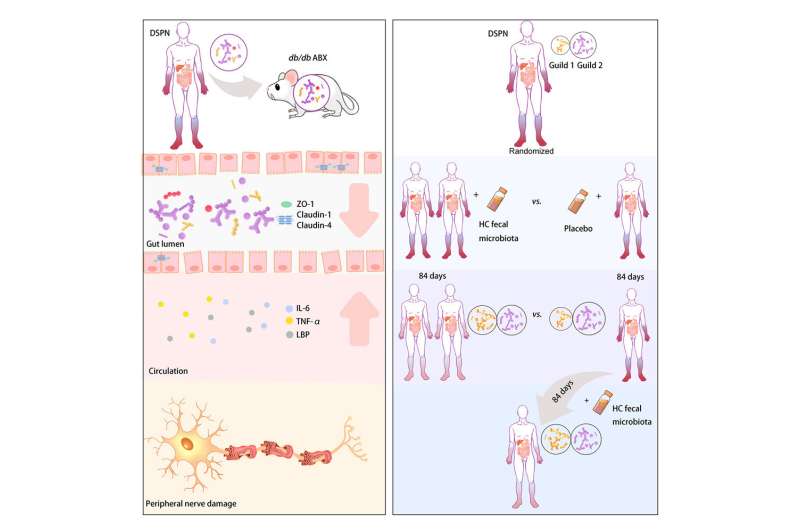July 17, 2023 report
This article has been reviewed according to Science X's editorial process and policies. Editors have highlighted the following attributes while ensuring the content's credibility:
fact-checked
peer-reviewed publication
trusted source
proofread
Fecal transplants correlated to distal symmetric polyneuropathy symptoms

Research led by the People's Hospital of Zhengzhou University, China, has found a connection between gut microbiota and distal symmetric polyneuropathy. In a paper, "Gut microbiota modulate distal symmetric polyneuropathy in patients with diabetes," published in Cell Metabolism, the team finds a potential causal role of the gut microbiota in distal symmetric polyneuropathy symptoms.
Distal symmetric polyneuropathy (DSPN) is a common, progressive and debilitating neuropathy complication closely associated with diabetes. Symptoms include toe and foot numbness, unsteadiness, and chronic pain in the hands and feet, which can result in an increased risk of falls, sleep disturbances and a negative impact on patient functionality, mood, and quality of life. DSPN is also a major risk factor for diabetic foot ulcerations, which can result in lower limb amputation and death.
According to the Centers for Disease Control, 37.3 million Americans (about 1 in 10) have diabetes. While more than half of all patients with diabetes will develop diagnosable DSPN, no effective treatments are available. The underlying mechanisms involved in DSPN are unclear, with some conflicting information about physiological correlations. This lack of understanding makes it difficult to develop treatments, as the effective targets for treatment are still unknown.
The gut microbiota has been implicated in maintaining glucose homeostasis and affecting the nervous system through the gut-brain and neuroimmune-endocrine axes. Previous studies have demonstrated the impact of gut microbiota on neurodegenerative disorders in the central nervous system.
Significant differences in gut microbiota composition have been previously observed in diabetes patients with and without DSPN. Based on converging evidence to suggest a causative role of gut microbiota in maintaining glucose homeostasis, involvement at the intersection of the gut-brain and the neuroimmune-endocrine axes, and the production of bioactive substances known to regulate inflammation, the research team decided to investigate the potential relationship between gut microbiota and DSPN using fecal microbiota transplantation (FMT).
Fecal microbiota transplantation experiments in mice from patients with distal symmetric polyneuropathy induced more severe peripheral neuropathy than transfers from patients with diabetes but no distal symmetric polyneuropathy and from non-diabetic subjects.
In a randomized, double-blind, placebo-controlled pilot clinical trial, FMT from healthy donors was conducted on 22 human patients with DSPN who responded poorly to conventional treatments. Compared to 10 patients who received a placebo, the results show a significant alleviation of DSPN symptoms after FMT, indicating a potential causal role of the gut microbiota in this disorder.
The study identifies key bacteria that may mediate the protective effect of the gut microbiota in DSPN using a genome-centric and guild-based approach. Two competing guilds of gut bacteria are identified: guild 1, associated with higher capacity in butyrate production and improved gut barrier integrity, and guild 2, associated with more genes in the synthetic pathway of endotoxin. Following FMT, an increase in guild 1 and a decrease in guild 2 are observed, aligning with the alleviation of DSPN.
The study suggests that the beneficial effects of FMT on DSPN are not solely mediated through improvements in glycemic control or alterations in certain metabolites. Instead, reducing endotoxin production and increasing the capacity for butyrate production from the gut microbiota may improve gut barrier function and reduce systemic inflammation.
The authors suggest FMT shows promise as a treatment option for DSPN by highlighting the causal relationship between the fecal gut microbiome swap and symptom presentation. The pathway presented in the current paper provides a good starting point for future research and could serve as preliminary data for a study working with a larger cohort size to validate and further investigate the observations.
More information: Junpeng Yang et al, Gut microbiota modulate distal symmetric polyneuropathy in patients with diabetes, Cell Metabolism (2023). DOI: 10.1016/j.cmet.2023.06.010
© 2023 Science X Network





















